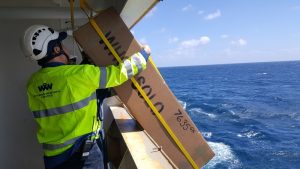 THIS SPRING, A COMMERCIAL SHIP CALLED TIJUCA SET OUT ACROSS THE NORTH ATLANTIC WITH SOME UNUSUAL CARGO: two tubular Argo instruments capable of measuring ocean temperature, salinity, and other marine properties. While relatively uneventful, the deployment of these instruments by a merchant vessel opens a new chapter for ocean monitoring. Under the Science Research on Commercial Ships (Science RoCS) initiative, research institutions and industry are collaborating to gather long-term, consistent scientific observations of the vast open ocean.
THIS SPRING, A COMMERCIAL SHIP CALLED TIJUCA SET OUT ACROSS THE NORTH ATLANTIC WITH SOME UNUSUAL CARGO: two tubular Argo instruments capable of measuring ocean temperature, salinity, and other marine properties. While relatively uneventful, the deployment of these instruments by a merchant vessel opens a new chapter for ocean monitoring. Under the Science Research on Commercial Ships (Science RoCS) initiative, research institutions and industry are collaborating to gather long-term, consistent scientific observations of the vast open ocean.
The National Oceanic and Atmospheric Administration (NOAA) estimates that more than 80% of the ocean is unexplored. Science RoCS aims to fill in some of those gaps, says Kerry Strom, marine operations coordinator for WHOI, which is spearheading the effort. With fewer than 100 research vessels worldwide—and more than 50,000 commercial ships sailing at any given time—“it will be a game changer” to have sensors on these “ships of opportunity,” Strom says.
“Imagine what we could accomplish in terms of science advancement with even just a 1% increase in ocean monitoring,” she says. Magdalena Andres, an associate scientist in WHOI’s Department of Physical Oceanography and a principal investigator on several Science RoCS proposals, says that data gathered by shipboard sensors can help ground-truth models or satellite data. This information could help identify harmful algal blooms, predict hurricane hot spots, or track changes in ocean chemistry that could affect fisheries, she says.
“If we want to solve problems that matter to people onshore, we need in situ observations of the ocean,” says Andres. “By complementing existing observing programs, Science RoCS will fill in those holes so scientists and stakeholders can address societally relevant problems.”

Wallenius Wilhelmsen Parsifal at the Port of Baltimore USA
Strom envisions a day when all commercial ships are built with a suite of scientific sensors appropriate for their trade routes. For now, the initiative offers vessel owners a simple yet innovative “RoCS box” packed with multiple scientific sensors. This makes installation more practical and ensures data streams are accessible to scientists and other stakeholders onshore. This year, Science RoCS has also installed application-specific sensors on ships, including a plankton recorder on a vessel headed around the world, and an instrument that measures dissolved carbon dioxide to gather data about ocean acidification.
Strom, whose background includes working in commercial shipping, says that the collaboration between scientists and industry has to be beneficial to both parties to succeed. That perspective was one of the reasons why the shipping company Wallenius Wilhelmsen was eager to collaborate on Science RoCS’ initial effort this spring.
“It makes sense for us to facilitate research into ocean currents, because that enables us to make our operations safer and more efficient,” says Roger Strevens,
vice president of sustainability for the company.
Strom anticipates that Science RoCS collaborations “will be the new norm” and that other companies will soon jump on board. “Why wouldn’t they get involved?”
she says. “They’ll look like a rock star, or in this case, a ‘RoCS star.’”